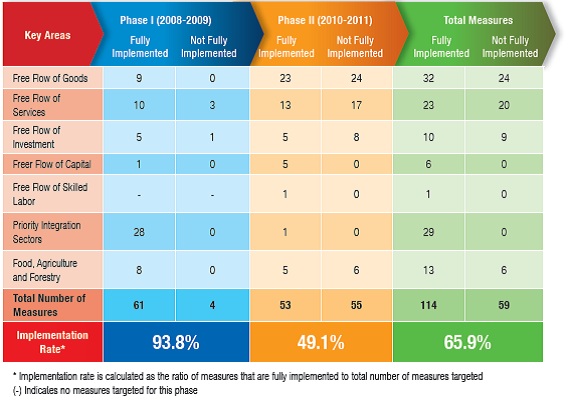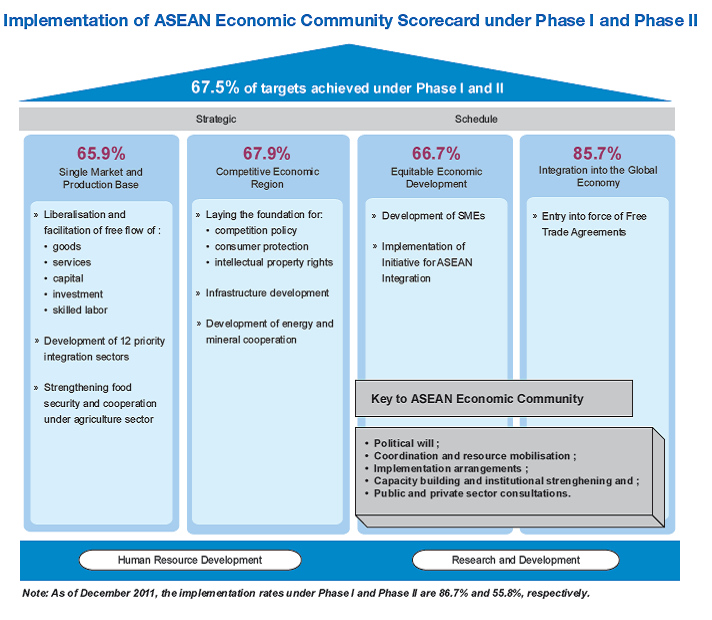The ASEAN Economic Community Scorecard: performance measurement for economic integration
The Association of Southeast Asian Nations (ASEAN) is an economic and political organization established in 1967 by Indonesia, Singapore, Malaysia, Thailand and the Philippines.
Thereon after the association expanded so as to include the countries of Brunei Darussalam, Myanmar, Cambodia, Vietnam and Laos. ASEAN is founded on the principles of economic advancement, social progress and intercultural enlargement in Southeast Asia and the Pacific.
The ASEAN Economic Community is the mechanism in charge of delivering an integrated economic region of Southeast Asia by 2015, while ensuring that AEC initiatives are accurately implemented. The AEC Scorecard was developed as a tool for monitoring and reporting on the progress of AEC measures for economic integration.
The AEC Scorecard provides quantitative and qualitative indicators that track the achievement of milestones according to the AEC Strategic Schedule and serve as a statistical barometer of the ASEAN Economic Community. Monitoring by means of the AEC Scorecard, starts with the definition of the AEC strategic goals, also referred to as, development pillars:
- A single market and production base
- A highly competitive economic region
- A region of equitable economic development
- A region that is fully integrated within the global economy
Under each of the four pillars, a performance scorecard is deployed. Within this scorecard, key areas of development are identified, and the implementation rate of measures is monitored. The implementation rate of measures is calculated as the ratio of measures that are fully implemented to total number of measures targeted.
Under the first pillar, implementation of measures is monitored for the free flow of goods, free flow of services and skilled labor, free flow of investment, freer flow of capital, priority integration sectors, food, agriculture and forestry. In terms of results, the AEC Scorecard reveals that 86.7% of measures under Pillar 1 were implemented, while noteworthy accomplishments were identified in the free flow of skilled labor and capital, as well as the integration of priority sectors.
The Competitive Economic Region Scorecard focuses on key development areas such as: competition policy, consumer protection, transport, energy, taxation, and e-commerce. The Scorecard reveals the fact that 67.9% of measures under Pillar II were implemented at the end of 2011, with significant progress being achieved in the areas of competition policy and regional cooperation for equitable resource distribution and economic use.
The Equitable Economic Development Scorecard measures the degree of implementation for measures in two key areas: Small and Medium-Sized Business Development and the Initiative for ASEAN Integration. Under this development pillar, 66.7% of targeted measures was achieved, while implementation of main initiatives in the key areas of development is considered to be on track.
The Scorecard for the AEC Integration into the Global Economy is focused on external economic relations. This Scorecard seems to reveal the best results because of ASEAN Free Trade Agreements with various countries such as: China, Japan, Australia, New Zeeland, India, as well as the Republic of Korea.
The AEC Scorecard concludes with an assessment of the path to achieving the Desired State of Evolution, which is the full implementation of measures for economic development and integration. Human resource development and research development seem to lay the foundations of this process. While the AEC has made significant progress in implementing the core measures for economic integration, improved monitoring for timeline achievement is necessary.
Cascading regional objectives to country level, has revealed the fact that in-country measures not being implemented, has negative impact on regional outcomes. Better alignment of implementation processes and timelines is at hand, as well as better coordination among national agencies. Engagement of the private sector has been identified as an area for improvement, as public and private sector consultation aid the impact and effectiveness of measures being implemented.
Finally, AEC progress monitoring by means of performance scorecards, has revealed that further efforts are necessary for the strengthening of the monitoring process, as target achievement within established timelines is a challenge that has been identified and has to be addressed.
Image sources:

Tags: Balanced Scorecard, Performance Management System






